Intel's Pentium M on the Desktop - A Viable Alternative?
by Anand Lal Shimpi on February 7, 2005 4:00 PM EST- Posted in
- CPUs
Overclocking to Save the Day?
Of course, the big question is - "What if you overclock it?"As you can expect, the Pentium M benefits greatly from being overclocked; not necessarily from the CPU being overclocked, but from the memory bus being overclocked. Unfortunately, as we mentioned before, the 855GME chipset and the two motherboards that we have based on it don't seem to want to overclock the memory bus too much, so we're left with somewhat nice performance gains from overclocking, but not ideal.
The problem with overclocking just the Pentium M is that it paints a skewed picture of reality - as comparing one overclocked processor to a ton of stock-clocked CPUs isn't really fair. But folks are always interested to see what an overclocked Pentium M can do, so we're here to show it off.
The beauty of the current Dothan based Pentium M CPUs is that they are 90nm chips, but without the heat issues of the Prescott based Pentium 4, meaning that they should overclock reasonably well. And overclock they do - our 2.0GHz sample easily hit 2.40GHz (133MHz x 18), and our 1.7GHz samples had no troubles getting up to 2.0GHz (one even hit 2.26GHz). We'd see bigger performance gains if we could bump up the memory clock beyond the 355MHz (to which we were limited), but that will most likely have to wait for new motherboards/chipsets.
Here are some abridged performance results with the overclocked Pentium M included:
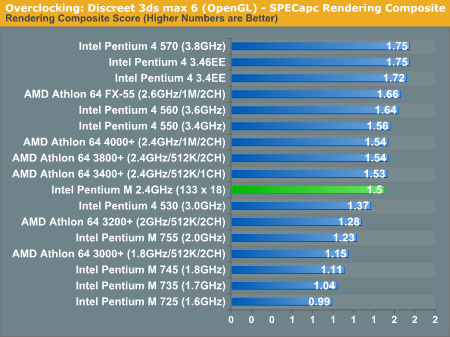

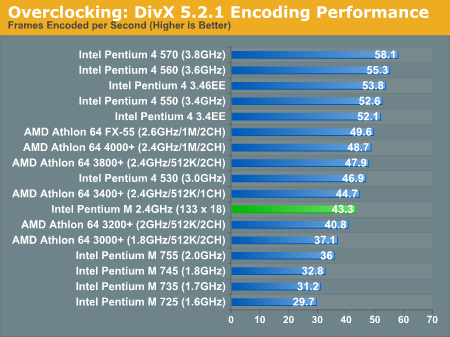
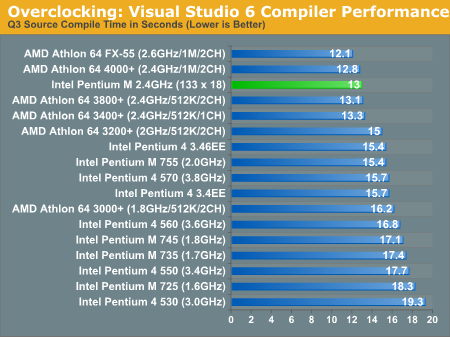
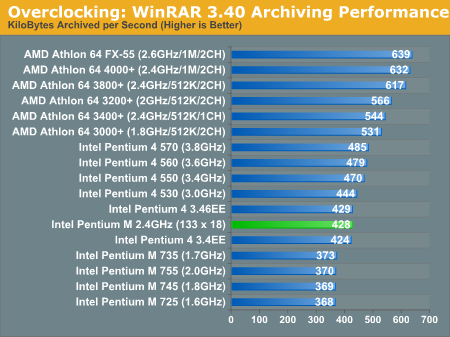
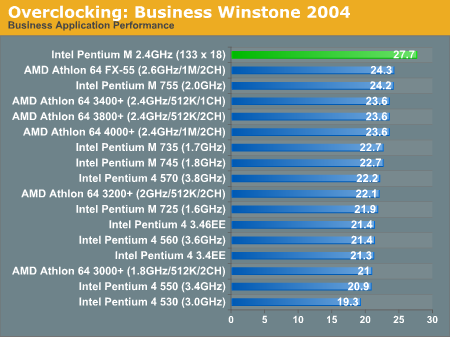
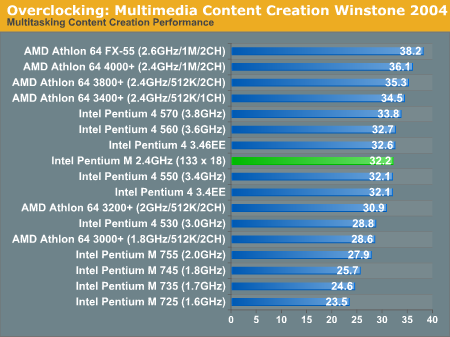
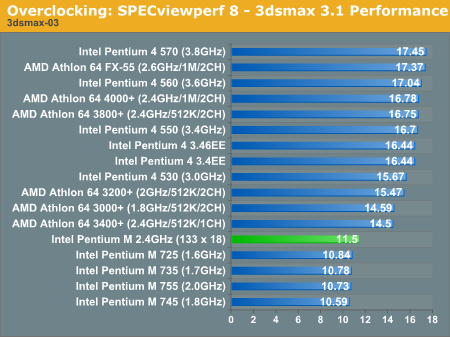
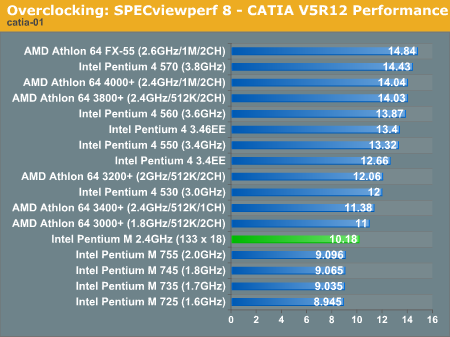

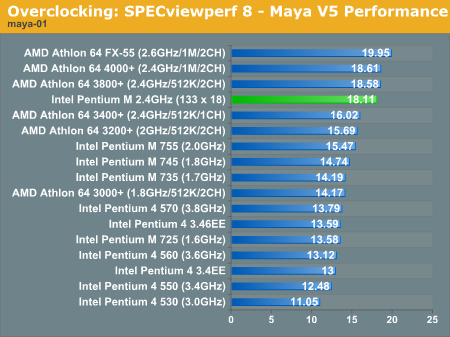
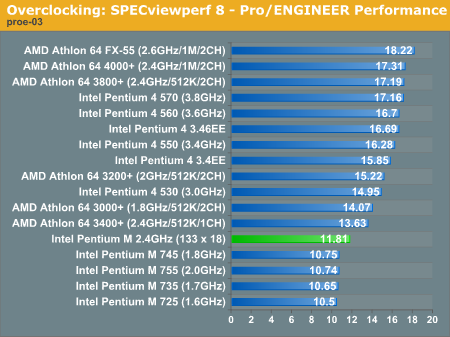
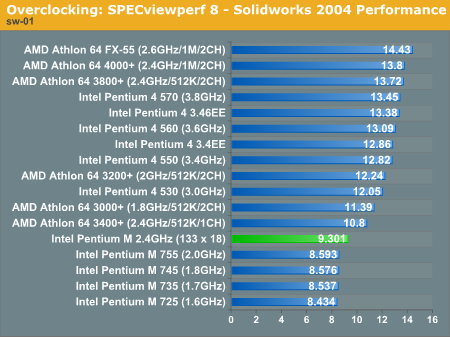
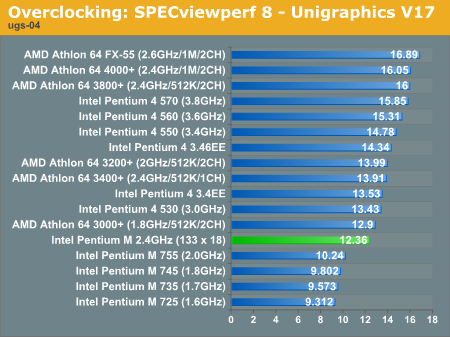










77 Comments
View All Comments
saratoga - Tuesday, February 8, 2005 - link
Overall this artical brings up a lot of the points missing in other Dothan reviews. Very nice work. Too many people have looked at a few benchmarks, bashed Intel for the P4, and missed the whole issue here.Intel isn't stupid. Its obvious they don't think Dothan will work in its current form as a desktop chip, and thats why they're still sticking with Prescott at the moment, and only bring the P-M over much later in a reworked form with Yohan. Assuming they ever do introduce a desktop chip based on the P-M.
Also, siginificant scaling out of Dothan seems unlikely. They'll probably get a few more speed grades out of it, but whoever was saying 3GHz was dreaming. Maybe at 65nm, but that sure as heck won't be dothan, and it won't be for a while yet.
PrinceGaz - Tuesday, February 8, 2005 - link
Well put classy, the P-M is a chip that at least in its current form can never be a desktop processor because of severe weaknesses in several areas.A faster dual-channel chipset will never make up for its poor FPU performance in heavy-duty applications, something I'd heard about many months ago but hadn't seen reliable benchmarks of until now.
If you want to do word-processing or browse the web, I'm sure the P-M will be very efficient. If you want to run the sort of spplications that seriously test a processor and are the reason you'd buy it in the first place for a desktop PC, then the P-M falls far short of the mark, in fact it is so far behind at times that it is embarrasing.
But you don't get anything for nothing, the P-M is great at doing easy stuff very quickly which is what laptops are used ofr mainly; but when the going gets tough, you want a real desktop processor like the A64 to keep things moving.
classy - Tuesday, February 8, 2005 - link
T8000What part don't you understand? The Pentium M has been reviewed all over the net. Out of all the reviews only one reviewer hit 2.8. Everyone else, was similar to Anandtech's results. 2nd I don't no where you been, but every review of an FX55 I have seen it routinely hits 2.8 with no problem. And almost all the lower speeds hit the 2.6-2.7 ballpark. Not mention that a small increase with A64 is much more signifcant than even a modest Intel OC because of the architecture of the A64 cpus. Hey everyone has a favorite cpu, video card, or motherboard maker. But when something is better, its just better. And for anyone to even remotely argue the Pentium M as a challenge to the A64 cpus is a bit silly. This chip reminds me a lot of the old 366@550 celery chips. IF you got a 366 to do 550 it was a great chip because it gave you nice performance for the price. The Pentium M doesn't have a price advantage and is on a platform that is outdated. IF you can overclock it to decent levels it performs pretty good in some aspects but still sucks in many others. The problem is IF. But as I stated ealier IF is out for the evening with MAYBE.
LackofVision - Tuesday, February 8, 2005 - link
I couldn't disagree more with the conclusions in this article.Anyone who can't see the promise of a desktop processor design based on the banias in't going beyond just looking at the numbers. Especially when you start thinking down the road about dual core's and the heat and performance bottlenecks associated with them.
So because the banias can't outperform the p4 or athlon64 in every benchmark, when hamstrung by an outdated chipset, and designed primarily for low power usage, the processor won't be competitive when running on a modern subsystem with a re tuning of the core design to make it more suited to the desktop?
Nothing like comparing apples to oranges and then drawing a conclusion on what a pear tastes like.
jamawass - Tuesday, February 8, 2005 - link
I doubt it, Intel makes huge profits by putting a price premium for mobile processors. They won't jeopardize this for a few enthusiasts.KristopherKubicki - Tuesday, February 8, 2005 - link
FrostAWOL, #51: What's your point? Those HP blade servers run Pentium Ms and there is no mention of Pentium 4 anywhere.Kristopher
HardwareD00d - Tuesday, February 8, 2005 - link
Pentium M = YawnT8000 - Tuesday, February 8, 2005 - link
#52Since it is very rare to see an A64 CPU overclock above the available speeds without subzero cooling, the comparision would likely be between a 2.4 or maybe 2.6 Ghz A64 and a 2.8 Ghz P-M.
Also, P-M CPU's with higher multipliers usually overclock better due to the limited FSB possibilities of the i855 chipset. This could explain why Anand did not reach 2.8 Ghz in this review.
dobwal - Tuesday, February 8, 2005 - link
While i think that this is a good article. Allowing us to see the performance of the dothan in its current state against desktop cpus. Some of the conclusions that are made by the author don't take account of alot factors.1. "The problem is that in the transition to the desktop world, its competitors get much more powerful, while the Pentium M is forced to live within its mobile constraints."
How can this statement be valid. The mobile constraints on the Dothan is never really removed. Nothing is really done to try to make the mobile dothan mimick a (possible) desktop variation of itself. Do you really think there is a chance for a official desktop dothan running at 2.4 with DDR 333 in single channel with 533 FSB. How about re-running these benchmarks along with a 3.2Ghz P4 with DDR 333 (single channel) and a FSB speed of 533.
2. "The fundamental issue is that although the Pentium M is surprisingly competitive with the Athlon 64 on a clock for clock basis, the Pentium M's architecture can't scale to the same clock speeds that the Athlon 64 can. The fact of the matter is that while the Pentium M will hit 2.26GHz by the end of 2005, the Athlon 64 will be on its way to 3.0GHz and beyond."
The fact of the matter is you are comparing the scalability of the king of mobile chips vs. the scalability of the king of desktop chip and making an assumption without taking account of all the factors involved. The fact is we do not know the scalability of the dothan without its mobile constraints. Even more so, we don't know the true scalability of the mobile Dothan. What other mobile cpu offers the same level of performance vs. battery life.
Its more profitable for a company to retard performance increases of its cpu if there is no other cpu that can offer the same level of performance currently or in the near future. Revisions or new steppings increase cost.
AMD is in the same boat with the A64.
How long has A64 been stuck on 2.4Ghz. Most of the latest PR number increases with relation to A64 have come from HT increases, dual channel and moving from 754 to 939. Imagine the scenario of where the Prescott worked as intended and the Tejas was around the corner. Do you think that the A64 would be still at 2.4Ghz or more like 3.0 or 3.2Ghz.
While some of the conclusions could be seen as true under the circumstances of Intel never officially introducing the dothan to the desktop world. Where all we get are mobile Dothans on chipsets with desktop features.
However, these benchmarks can't prove or disprove the viability of a dothan that was devised by Intel to be a desktop competitor.
classy - Tuesday, February 8, 2005 - link
#55IF Intel does this. IF Intel does that. Unfortunately IF left with MAYBE and they went to the movies to see the new #1 movie from Intel, Could Have, But Didn't, starring Mr Dothan CPU. :)